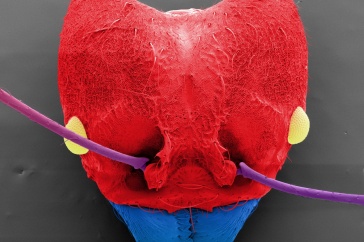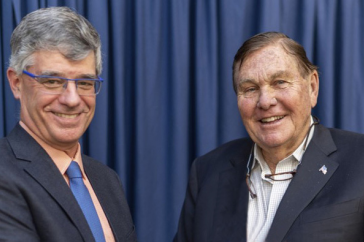
UNH neurobiology student Cody White ‘13 and zoology professor Win Watson investigate circadian rhythms.
Editor’s note: Supported by a $15.4 million award from the National Institutes of Health, the New Hampshire IDeA Network of Biomedical Research Excellence (NH INBRE) aims to increase the state’s research capacity and the scientific knowledge of its workforce. Leading the coalition is Dartmouth, which oversees the awarding of NH INBRE grants and provides technical support and mentoring to partners in the coalition, including UNH. This three-part series profiles UNH faculty and students who are involved in NH INBRE. It begins with the story of a UNH professor whose work on biological rhythms is providing research opportunities for UNH undergraduates and for faculty at two state colleges.
As zoology professor Win Watson gives a visitor a tour of his lab, he offers an intriguing scenario: “Imagine if I was able to take your brain out and keep it alive in the dark.”
That’s impossible, of course, not to mention a bit macabre, so Watson has removed the brain of a horseshoe crab, or Limulus polyphemus. He records the brain’s output on the last day of its life, looking for bursts of activity that would indicate the brain is trying to tell the animal to perform a particular activity – evidence of an internal clock that governs activities even in the absence of environmental cues.
“We know that all animals have these clocks,” he says. “We know that humans have these clocks. We just don’t know quite how they work. We don’t know how they communicate with the rest of the body.”
Watson’s research ultimately has applications to human health, because faulty clocks can lead to serious disorders. It also exemplifies the kind of teamwork and mentoring that NH INBRE makes possible. With support from the program, Watson is collaborating with faculty at Plymouth State University and New England College and is currently working with four UNH undergraduates. The students include neuroscience major Cody White ’13, who hopes to continue this research in graduate school. “You can never get bored with it,” White says. “The story just continues to unfold.”
The goal is to better understand what influences the rhythmic activities of certain animals. For instance, horseshoe crabs express tidal (12-hour) rhythms in the laboratory; they are active whenever it is supposed to be high tide. Watson and Chris Chabot, a biology professor at Plymouth State University, are trying to find the clock that controls these tidal rhythms and figure out how it functions. Among their questions: Does a tidal clock work the same as a circadian (24-hour) clock? Do they use the same molecules?
“We’re trying to identify all kinds of interesting genes in these animals,” Watson says. “That opens up a lot of cool opportunities – especially with horseshoe crabs because they’re a very ancient species. It’s like looking back in time when you look at their biology.”
Particularly suited to neurophysiological study is Melibe leonine, commonly called the hooded nudibranch, because of its highly accessible nervous systems. This marine invertebrate is similar to a sea slug. Together with James Newcomb, Watson’s former graduate student and now an associate professor of biology at New England College, Watson is examining how the clocks of M. leonina work at the cellular level to express behaviors such as swimming and feeding.
That is far beyond what we know about the human nervous system, Watson says. “We have very little idea how our brain works – like what enables you to write with a pen – on the level of how individual cells interact with each other.”
Understanding the workings of clocks in horseshoe crabs and M. leonina ultimately has implications for humans. Because biological rhythms affect our behavior, an out-of-sync clock can cause mental and physical disturbances such as insomnia and seasonal affective disorder. “The more people know about clocks, the more they realize they lie at the heart of some of these problems,” Watson explains. “These clocks have a big impact on your health, and they influence all aspects of your physiology. With these animals we’re trying to understand it at a very basic level because we can work on them in a way we can’t work on humans.”
That’s partly why this research interests White, who has investigated circadian rhythms in Watson’s lab for more than a year. One study he’s worked on involves the lobster Homarus americanus, which is active at night and inactive during the day. Even without light, the lobster mostly maintains this 24-hour rhythm, suggesting it has a biological clock that regulates its behavior. White’s research indicates that the protein cryptochrome plays an important role in synchronizing the lobster’s clock to the light/dark cycle.
White, who’s interested in the link between observed behavior and molecular processes, finds this area to be an exciting frontier. He’s applying for admission to graduate school in the fall – and he may have a chance to keep learning from his mentor: “If I am able to continue on at UNH for a master’s program in biological sciences, then I’d like to continue the project I’ve been working on with Win.”
Originally published by:
UNH Today
Written by Sonia Scherr '13 MFA



















































